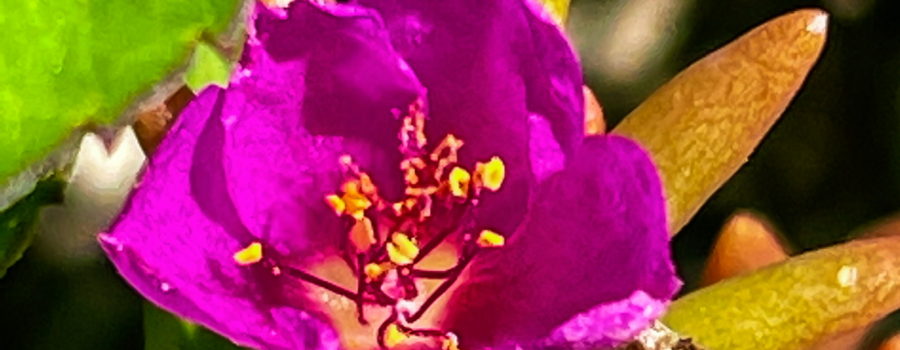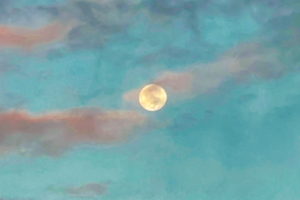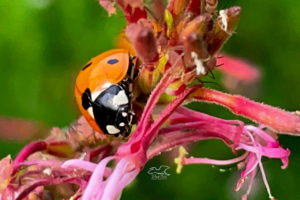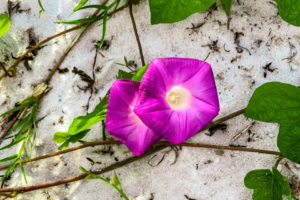Pink Purslane: Weed, Beautiful Ground Cover, or Incredible Medicinal Plant?

Winter has finally fully arrived in north central Florida. We had a significant frost on Tuesday morning, and hard freezes are forecast for tonight and tomorrow night for sure and possibly the next few nights as well. As an aside, so far the hibernaculum of paper wasps that have taken up residence on my front porch have survived. I’ll have to see how they do the next couple nights. The frost on Tuesday pretty much did in any remaining wildflowers that were still struggling to put out the occasional bloom, so for tonight’s post I’m going to go back to August. I spend quite a bit of time some days outside in our play yards walking pre-op or post-op dogs, and while I’m waiting for them to do their business, I have time to look around at the plants, flowers, and wildlife that frequents the area. On more than one occasion, I’ve found something interesting out in our play yards, so I try to remember to take my phone with me when I go out, but most of the time I forget. In July and August we had several small plants with small, bright pink flowers growing in one of the yards. I would see them in the early morning, but by early afternoon the flowers were closed up tight. I tried for days to get some photos, and one morning, I finally remembered my camera on an early walk and had a dog with me who wasn’t trying to “help” me get my images.

When I identified the plants, I wished I had dug them up and brought them home with me. Unfortunately, the day after I got the photos the guys mowed the play yards and my pretty pink flowers were gone! It turns out that these were pink purslane (Portulaca pilosa), also known as kiss-me-quick, hairy pigweed, shaggy portulaca, or Florida rose moss. They are native to the southern United States, Mexico, Central America, and parts of South America. They are closely related to several of the non-native purslanes that are used as ornamentals, and some people around here do use them as ornamentals or as ground cover, which is what I would like them for. They are small, annual succulents that spread via seeds and rhizomes. Once established, they require very little care, and they will bloom throughout much of the year. Sounds like an ideal plant in my mind! But many people count them as weeds, because they are quite hardy, will grow in quite a variety of soils and conditions, and easily out compete “desirable” plants like grass and many ornamentals. Their seeds can actually remain dormant in the soil for forty years, and still germinate when the conditions become right!

These tough little plants are also great for attracting several types of wildlife. The flowers, of course, attract many small pollinators including skippers, bees, ants, and wasps. Quail, turkeys, and other wild birds will eat the leaves and the flowers, and several types of moth and butterfly caterpillars will eat the leaves and stems. Herbivores like deer, rabbits, and gopher tortoises also love the juicy leaves and flowers. The seeds can be eaten by squirrels, mice, and of course many seed eating birds. And, in fact, this plant is sometimes eaten by people, as well. It is high in vitamins A and C as well as omega-3 fatty acids. New leaves, especially the tips, can be eaten in salads and sandwiches, used as thickeners for soups and stews, and used as an edible garnish for other dishes. Seeds can be collected and ground into flour for use in baking. As well as being eaten for nutritional reasons, pink purslane also has quite a few medicinal uses. Ground leaves are used to make a poultice for wounds, burns, and sunburn, while the juice from the leaves was used by native Americans to treat earaches. A syrup made from the leaf juice is also supposed to relieve dry coughs. In traditional Chinese medicine pink purslane is used to treat infections and dysentery.
As you can see, one man’s weed can be another man’s desired flower (like so many of our native plants). I hope the pink purslane returns to our play yard come springtime. If I can spot it before it gets run over by the mowers and weed eaters again I’m going to nab it and see if I can’t plant it on some of my yard’s many bare spots. Then, of course, I will have to hope that the dogs will leave it alone long enough for it to get established. We will see how it goes!
If you enjoy beautiful nature photography and nature inspired artwork along with interesting and engaging content related to nature, then you’ll love this blog. Subscribe below and check us out!





Recent Comments